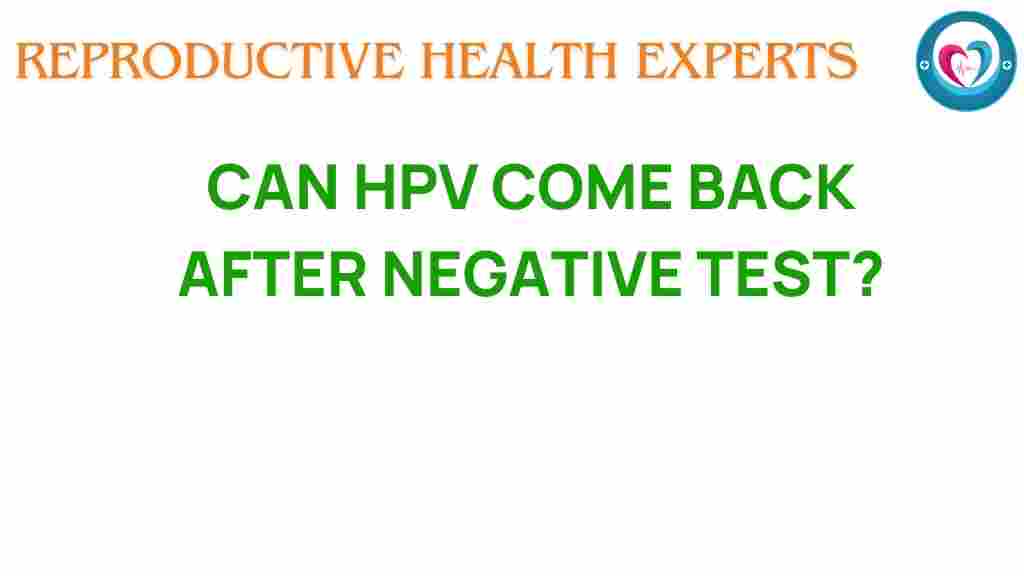The Surprising Truth: Can HPV Really Return After a Negative Test?
Human Papillomavirus (HPV) is a common sexually transmitted infection that can have significant health implications. With over 100 different strains of the virus, some are harmless, while others can lead to serious health risks, including cervical cancer. After undergoing screening and receiving a negative HPV test result, many individuals may wonder: can HPV really return? This article will explore the complexities of HPV testing, the possibility of recurrence, preventive measures, and dispel common myths surrounding the virus.
Understanding HPV and Its Tests
Before diving into the potential for HPV recurrence, it’s essential to understand what HPV is and how screening works. HPV is primarily transmitted through intimate skin-to-skin contact. Most sexually active individuals will contract HPV at some point in their lives, but for the majority, the virus is cleared by the immune system without any symptoms.
HPV Testing Explained
HPV testing is typically performed through a Pap smear, which checks for changes in cervical cells. If abnormal cells are found, further testing may be conducted. A negative HPV test result indicates that there is no detectable virus at that moment. However, this does not guarantee that the virus won’t return in the future.
Can HPV Really Return After a Negative Test?
Yes, HPV can return even after a negative test. Here are several factors to consider:
- Latency of the Virus: HPV can remain dormant in the body, meaning it may not show up on tests even if it is present.
- New Infection: A negative test does not protect against future infections. An individual can contract HPV again through sexual contact with an infected partner.
- Immune Response: The immune system plays a crucial role in managing HPV. If the immune system is compromised, the virus may reactivate.
Health Risks Associated with HPV
Understanding the health risks associated with HPV is critical for awareness and prevention. While most HPV infections are cleared without any intervention, some strains pose significant risks:
- Cervical Cancer: Certain high-risk strains of HPV are directly linked to cervical cancer.
- Other Cancers: HPV is also associated with cancers of the throat, anus, vulva, vagina, and penis.
- Genital Warts: Low-risk HPV strains can cause genital warts, which can be uncomfortable and distressing.
Prevention and Awareness
Preventing HPV infection is key to reducing health risks. Here are some effective strategies:
Vaccination
The HPV vaccine is one of the most effective ways to prevent HPV-related health issues. It is recommended for preteens, but vaccination can be beneficial for individuals up to 45 years old. The vaccine protects against the most common high-risk HPV strains and can significantly reduce the likelihood of developing cervical cancer.
Regular Screening
Regular screenings are crucial for early detection of any changes in cervical cells. Women should follow the recommended guidelines for Pap smears and HPV testing:
- Starting at age 21, women should have a Pap test every three years.
- At age 30, women can choose to have a Pap and HPV co-test every five years or a Pap test alone every three years.
Safe Practices
Engaging in safe sexual practices can greatly reduce the risk of contracting HPV:
- Condom Use: While condoms do not provide complete protection against HPV, they can significantly reduce the risk of transmission.
- Limiting Partners: Reducing the number of sexual partners can decrease the risk of exposure to HPV.
Myths and Misconceptions about HPV
There are many myths surrounding HPV that can perpetuate fear and misinformation. Here are some common myths debunked:
- Myth 1: HPV is only a woman’s issue.
Fact: HPV affects both men and women and can lead to various cancers in both genders. - Myth 2: You can only get HPV if you have multiple sexual partners.
Fact: HPV can be transmitted through skin-to-skin contact, making anyone sexually active at risk, regardless of the number of partners. - Myth 3: A negative HPV test means you’re free of the virus forever.
Fact: As discussed, HPV can remain dormant and may recur later.
Troubleshooting: What to Do After a Negative Test
If you receive a negative HPV test result, it is essential to stay informed and proactive about your health. Here are steps you can follow:
Stay Informed
Educate yourself about HPV and its risks. Understanding the implications of your test results can empower you to make better health decisions.
Follow Up with Your Healthcare Provider
Maintain regular check-ups and screenings per your healthcare provider’s recommendations. Discuss any concerns or symptoms you may experience.
Practice Healthy Habits
Adopt a healthy lifestyle to support your immune system. This includes:
- Eating a balanced diet rich in fruits and vegetables.
- Exercising regularly.
- Avoiding tobacco and excessive alcohol consumption.
Communicate with Partners
Open communication with sexual partners about HPV and safe practices is crucial. Discussing sexual health can foster a supportive environment.
Conclusion
In summary, while a negative HPV test is reassuring, it does not guarantee that the virus cannot return. HPV can remain dormant or be contracted anew. Awareness, vaccination, regular screenings, and safe sexual practices are vital in preventing HPV-related health risks. By debunking myths and promoting education, we can foster a better understanding of HPV and its implications for both men and women. Remember, staying informed and proactive is the best way to protect your health.
For more information on HPV and health risks, visit CDC HPV Information. To learn about HPV vaccination, check with your healthcare provider or visit this resource.
This article is in the category Conditions and created by ReproductiveHealthExperts Team
